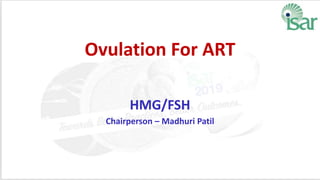4. OI for ART cycles.pptx
- 1. Ovulation For ART HMG/FSH Chairperson – Madhuri Patil
- 2. Aim Of Ovulation Induction Pharmacological agents initiate, augment or modulate the hormonal & gametogenic response of the ovary Overcome natural follicular selection process to increase the number and quality of oocytes available for fertilization Induction of follicular growth Time IUI and OR
- 3. Before starting ovarian stimulation Analysis of the ovarian reserve Define goal of ovarian stimulation Select the correct stimulation protocol
- 4. Select the correct stimulation protocol Most Individualized protocols based on following parameters of ORT COS Age FSH AMH AFC Amended further for BMI Objective should be to Optimize response and outcomes minimizing the risks
- 5. OI initiated on Day 2/3 only if Follicular size is < 10 mm Absence of ovarian cyst Endometrial thickness < 6 mm Pre-requisites for OI OI drugs should be started on day 2-3 of the MC as Selection of dominant follicle - early follicular phase
- 6. Types Of Ovarian Stimulation For ART Methods Aim Natural cycle (unstimulated / spontaneous) No medication Single Oocyte Modified natural HCG only FSH / HMG and GnRh antagonist add backs Single Oocyte Mild or Minimal Stimulation Low dose FSH / HMG Oral compounds GnRH antagonist 2 – 7 Oocytes Conventional standard routine COS GnRH agonist or Antagonist Conventional FSH / HMG dose > 8 Oocytes
- 7. Scott M. Nelson, Ph.DFertility and Sterility 2013 Protocol Choice based on AMH and AFC
- 8. Ovarian response depends on: presence of other infertility factors genetic: FSH and LH receptor polymorphism past performance to COS risk tolerance FSH-sensitive follicle cohort type of stimulation regimen used type of GnRH analogs used dose of GT
- 9. Choosing the GnRH analogues Non-PCOS GnRH agonist Long or short GnRH antagonist PCOS GnRH Antagonist
- 10. Fixed and Flexible start multiple Dose Single dose Protocol GnRH Antagonist Protocols Used in all group of patients Should be used in all PCOS Women
- 11. GnRH agonist Protocols Norma Responders Results in an uniform cohort Poor Responders Can cause premature rise in P4
- 13. Comparison Between Long GnRH agonist and Antagonist Protocols
- 14. Advantages of Long GnRH agonist Protocol : Uniform cohort More oocytes Increased pregnancy rate Suitable for normo responders Disadvantages of Long GnRH agonist Protocol : Increased duration of COS Increased cost Increased stress – financial / emotional Increased complication – OHSS Advantages of Short GnRH agonist Protocol : Utilizes the initial temporary flare effect for follicular recruitment followed by pitutory desensitization More suitable for older patients and poor responders Reduces dose of injection and duration of COS Disadvantages of Short GnRH agonist Protocol : Unphysiological LH increased in early phase Reduced pregnancy rates as compared to long protocol Advantages of GnRH antagonist Protocol: Patient friendly – reduced injection and shorter duration of stimulation Minimal side effects Reduce risk of complications – OHSS Disadvantages of GnRH antagonist Protocol Uniform cohort of follicles may not develop Increase in dose of GT may be required one antagonist initiated:
- 15. Ovulation Induction Protocols Oral ovulogens+ GT CC/Tamoxifen stimulates recruitment of number of small follicles & GTs sustains the growth of recruited follicles
- 16. Conventional Step-up protocol Supraphysiological doses of FSH provoke initial development of a large cohort, stimulate additional follicles, and even rescue those follicles destined to undergo atresia
- 17. Step -down protocol Monofollicular development achieved More physiological Loading FSH dose (100 – 200 IU/d) decreased by 37.5IU every 3-5 days
- 19. Chronic Low dose protocol Treatment cycles long – 28 –35 Days, Reduced Multiple folliculogenesis and OHSS Dose increment to a maximum of 225 IU/day Once dominant follicle emerges, dose of FSH maintained same until the follicle reaches 18 mm
- 20. Step -down protocol Risk of multi-folliculogenesis and OHSS reduced FSH threshold dose decreased by 50% when leading follicle 14 mm
- 21. Long acting FSH
- 22. Predict response To tailor correct stimulation regimen For adequate response so as to prevent complications To improve pregnancy outcomes Evaluation of Ovarian Reserve Markers Improve Efficacy, Safety & Cost Effectiveness of Treatment
- 23. Modifying conventional stimulation protocols according to patients’ characteristics and ovarian reserve makes it patient- friendly and optimizes the chance of LBR Take home Message -------
